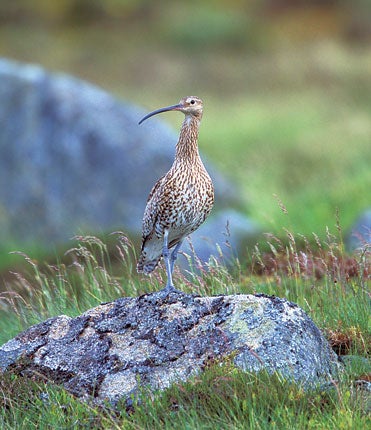Rapid decline could make curlew extinct in Ireland in decade

The curlew, the wetland wader with the decurved bill and haunting call, has almost vanished from Ireland in a mere 20 years, in one of the most dramatic declines ever recorded for a bird in the British Isles.
From a breeding population estimated at 5,000 pairs in 1991, the Irish curlew's numbers have dropped to fewer than 200 pairs today, which if the estimates are correct would represent a staggering decline of more than 96 per cent. It is feared than in another decade the bird could be extinct.
"Everything points to a decline which is truly catastrophic," said Anita Donaghy of Birdwatch Ireland, who led a survey of curlew numbers this spring. "We could hardly believe the results we were getting."
The survey looked at 60 sites which previously held curlews in Donegal and Mayo and found that only six of them were occupied – with a total of only eight pairs, four in Mayo and four in Donegal.
Recently completed fieldwork for the new Atlas of the Breeding Birds of Britain and Ireland, which will be published in 2013, shows how much the range of the bird has shrunk since the last version of the book was published 20 years ago.
In Britain, where it is still fairly numerous, the curlew's range – defined as the number of 10km grid squares in which it is recorded breeding – has contracted by 14 per cent over the period. In Ireland the contraction is 61 per cent, and this year's BirdWatch Ireland survey looked at total numbers rather than range, where the decline is seen as greater still.
Dr Donaghy said observations indicated that changes in land use were behind the drastic drop. Curlews nest in damp, rushy pastures and on open moorland, using their long, curved bills to probe for food in soft, wet areas along ditches or in shallow pools where their chicks can easily find insect food.
But these sorts of areas, once common in Ireland, are disappearing with developments such as the commercial extraction of peat from bogs, the planting of forests, more intensive management of grasslands and even the construction of wind farms, Dr Donaghy said. While there were no actual studies showing that wind farms had a negative effect, it was unlikely that curlews would breed in their vicinity, she said.
BirdWatch Ireland is running its Cry of the Curlew Appeal to put protection measures in place. "Our research has shown that the curlew breeding population is in an even more perilous state than we thought," its chief executive, Alan Lauder, said. "Unfortunately the remaining funds are not adequate to take the action needed to identify the remaining pairs and put measures in place to protect them."
Join our commenting forum
Join thought-provoking conversations, follow other Independent readers and see their replies
117Comments